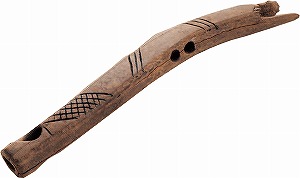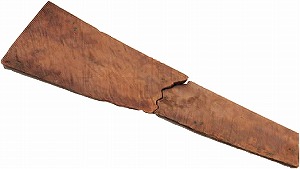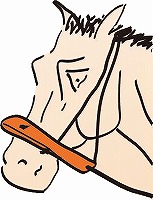
NABUNKEN NEWS vol.47
"Omogē", the deer horn horse-gear
When I saw an unidentifiable deer-horn artifact unearthed from the Otomo-funaimachi site, Oita city, for the first time, I firmly believed that it was a kind of a horse-gear called "Omogē" and, later "Hyoshi" in Minami-jima Island in the Edo era.
Omogē is a left-and-right pair of horse gear made of deer horn that holds the muzzle of a horse between them. The upper holes are used to tie the right and left sides with string; meanwhile, the two small holes in the middle are used to fix the gear by extending a string around the back of the horse's head to prevent it from sliding down, and, thus, to control the horse by fastening or loosening the string passing through the lower hole to make the horse understand the coachman's intention.
Although a large number of wooden horse-gear to hold the muzzles of horses (not snaffle-bit type) still remain today, the one unearthed from the Otomo-funaimachi site was the first deer horn gear as an archaeological artifact. This gear imposes lower strain on a horse, although it is easily broken due to excessive load on the lower edge. Accordingly, it is considered that this gear was broadly used for workhorses.
(MATSUI Akira, Center for Archaeological Operations)
 Deer horn "Omogē "unearthed(full scale) |
 Omogē You can see processing such as decorations and boring holes on the surface of the Omogē shown upper left. |
 A spatula-shaped deer horn artifact excavated at the same time as the "Omogē " Meanwhile, the spatula-shaped deer horn artifact is produced by scraping/forming a deer horn to be flat. This artifact may have been a kind of plectrum for a stringed instrument. |
 Original: "Illustrated Handscroll of the Legends of Ishiyama- dera Temple" |
